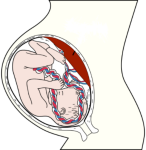What’s a doula?
A doula is a professional part of the birth care team. Birth Doulas provide continuous physical, emotional and informational support to their clients through pregnancy, birth & early postpartum. In much of the world today and throughout history, women support women through labour & birth.
What’s the difference between a midwife and a doula?
Doulas work as part of a team with doctors or midwives, but not instead of. They provide non-medical support and comfort measures (e.g. encouragement, massage, positioning suggestions). They do not perform clinical tasks such as heart rate, blood pressure, or internal exams.
Midwives are medical providers, highly trained in the medical aspects of birth. The carry oxygen, medicines, resuscitation equipment and other gear, and are known as primary care-givers during birth. In North America primary/medical birth care is offered by either a midwife or a physician.
Why choose a doula over simply using a friend or family member as support?
Doulas are trained and experienced in childbirth support. They know the sounds and behaviors of laboring women, and what that may indicate about progress. Doulas are trained in pain-reducing comfort measures, natural methods to keep labor progressing, and to support the laboring people and partners / birth companions. Doulas are familiar with local hospital policies & practices and have often built a rapport with the doctors, nurses and midwives. See http://evidencebasedbirth.com/2012/06/26/why-wouldnt-you-hire-a-doula/
In most Canadian hospitals, maternal patients are allowed 2 support persons – usually that’s a partner and a support person. Some hospitals accommodate a 3rd support person. Homebirths and birth centers encourage women to have all the support they wish.
How does the doula fit in with nursing staff?
Doulas do not replace nurses or other medical staff, but rather work as part of the team. Doulas provide comfort and support while nursing staff take care of medical needs and charting (often in a supportive manner of course). Nurses change shifts; doulas stay.
How does a doula assist with communication in hospitals during labor & birth?
During prenatal meetings doulas learn what’s important to clients and discuss how to make informed decisions. A doula may remind or encourage their client to ask the questions necessary to understand a procedure and make informed decisions. Doulas do not speak on a client’s behalf nor intervene in their clinical care. They do not make decisions for clients, nor judge the decisions clients’ make, but are there to support those decisions.
What difference does the presence of a trained doula have on birth outcomes?
The presence of a doula tends to result in shorter labours with fewer complications and less interventions. When a doula is present during and after childbirth, women report greater satisfaction with their birth experience, make more positive assessments of their babies, have fewer caesareans and requests for medical intervention, and less postpartum depression. In case of unplanned circumstances, doula support helps reduce negative feelings about one’s childbirth experience. Studies [1],[2],[3],[4] have shown that babies born with doulas present tend to have shorter hospital stays with fewer admissions to special care nurseries, breastfeed more easily and have more affectionate mothers in the postpartum period.
Analysis of six randomized trials1 demonstrates that lack of doula presence correlates with:
- Double the overall caesarean rate
- 33% increase in length of labour
- 67% increase in oxytocin use
- 2 ½ times more requests for epidurals
Will a doula make my partner feel unnecessary?
A responsible doula compliments and enhances the father / partner / birth-companions in their supportive role rather than acting as a replacement. (While I respect people’s individual circumstances, I will use “father” words for most of this paragraph, as that’s who most often asks this question.) The presence of a doula allows the father to support his partner emotionally during labor & birth without the pressure to remember everything he learned in childbirth class! The father typically has little-to-no actual experience with the birth process, yet is expected to act as a “coach”. Some partners feel (accurately) that this is a huge expectation. Many fathers experience the birth as an emotional journey of their own and find it hard to be objective. A doula is supportive to both the birth-mother and her partner, and plays a crucial role in helping a partner become involved in the birth to the extent they feel comfortable. Studies have shown that fathers usually participate more actively during labor with the presence of a doula than without one.
When a couple works well together during the birth process they’re better able to handle the challenges of early parenthood. An incredible bond forms or is made stronger.
How often and when do we meet?
After we’ve met and agreed to work together, we’ll meet at least twice more before the birth; as many times as we need to feel prepared. I do not charge extra for additional meetings. It’s never too early to start our meetings and I ask that the two main meetings are complete by 35 weeks, ideally. After your baby is born there will be a minimum of one postpartum visit, more if needed or desired. I welcome questions and communication from my clients between meetings.
Are doulas only useful if planning an un-medicated birth?
The role of the doula is to help attain a safe and pleasant birth, not to choose the type of birth. The presence of a doula is beneficial no matter what type of birth is planned. In fact, people who choose a medicated birth need as much support as those who choose a natural birth, but a different kind of support. For women who know they want a medicated birth, doulas still provides emotional support, informational support and comfort measures to help through labor and the administration of medications. Doulas can help with possible side affects and by filling in the gap that medication may not cover; rarely does medication take all discomfort away and sometimes there’s a wait involved.
For a people who are facing a caesarean birth, a doula provides comfort, support and encouragement. Often a caesarean is an unexpected situation and parents-to-be can be left feeling unprepared, disappointed and lonely.
What if I planned a drug-free birth then change my mind during labour?
Doulas don’t make decisions for clients or intervene in clinical care, nor do they judge their choices. They provide informational & emotional support while respecting their client’s decisions.
What kind of comfort measures do you use during the labour & birth process?
While there are common comfort measures taught in doula training courses, each doula also brings their own tools and methods. Mine include the following:
- Positioning suggestions specific for stages of labour, circumstances, client preferences, situations that arise through the birth process
- Massage & various touch methods
- Homeopathy & Bach Flowers (optional; no extra charge)
- Aromatherapy (optional, you provide the oils; only available out of hospital due to scent policies)
- Encouragement & reassurance
- Setting up the birth space
- Heat or cold as desired
- Hydrotherapy (water for comfort in labour, and/or water-birth)
- Create space for partner, and recommendations to help partner to offer support
- A calm, reassuring presence who trusts the birth process
When do we call you in labour?
Details are discussed in our prenatal meetings. Please call at the first signs of suspected labour. From then on you’ll keep us posted on your progress and what’s happening.
When and where do you join us in labour?
That depends on the labouring person, partner, and what’s going on in labour. Early support often takes the form of checking in by phone and/or dropping by your place. Your doula joins you either at your home or in hospital or birth center once you need in-person support and remains with you until 2-3 hours after the birth.
How does shared-care work?
Doulas often team up to provide enhanced service through busy times, holiday seasons, summertime. Clients benefit from combined experience, education, and availability. Since doulas are on call for up to a month for each client, shared care allows them time for important life events and days off without having to turn clients away or rely on unfamiliar back-up. Clients may wish to meet both doulas prenatally so they’re familiar with whichever one attends birth. In cases of unusually long labours, a doula-colleague may be called in to provide a break for the primary doula.
What if you can’t be at the birth?
In the rare circumstance that your doula can’t be there, you will be well supported. I work with reliable back-ups who offer excellent care. Fees remain the same. If the back-up is likely to be part of care, a meeting with my doula-colleague can be arranged.
Do we pay more to work with 2 doulas?
No. Fees are outlined in the Client Agreement. The cost covers doula services, no matter how many doulas are involved.
What kind of postpartum support do you offer?
Your birth doula usually stays for 2-3 hours after the birth, until you’re ready to be on your own with your baby. Your doula will be visit on the first day or two postpartum, offering basic breastfeeding support, answering questions, and going over your birth. I am available for questions and can offer resources (educational and community). A second postpartum visit is offered.
What if I need extra help with breastfeeding or baby-care?
The information above describes care provided by birth-doulas. Another kind of doula, a “postpartum doula”, specializes in extended care and breastfeeding support. There are also breastfeeding counselors and lactation consultants that can be arranged through public health or hired privately. I can provide resources and contact info for them. If you’re on the Mother-Baby Unit the nurses or unit Lactation Consultants can provide support.
Where’s that name from?
In ancient Greece “doula” meant the highest female servant who helped the “lady of the house” through child-bearing. Medical researchers Marshall Klaus and John Kennell, who conducted several randomized clinical trials on the medical outcomes of doula attended births, adopted the term to refer to labour support as well as prenatal and postpartum support.
[1] Klaus, M.H.; Kennel, J.H.; Berkowitz, G.; Klaus, P. “Maternal Assistance and Support in Labor: Father, Nurse, Midwife or Doula?” Clinical Consultations in Obstetrics and Gynecology 4 (December 1992).
[2] Sauls, DJ. Effects of labor support on mothers, babies, and birth outcomes. J Obstet Gynecol Neonatal Nurs. 2002 Nov-Dec; 31(6):733-41.
[3] O’Driscoll, K. and Meagher, D. Active Management of Labor. 2d ed. London: Bailliere Tindall, 1986.
[4] Klaus, M.H. and Kennel, J.H. Parent-Infant Bonding. St. Louis: C.V. Mosby, 1982.



 Baby in optimal position: head down and flexed, back out.
Baby in optimal position: head down and flexed, back out.







